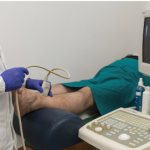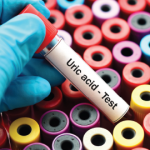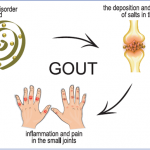(Reuters)—Ironwood Pharmaceuticals Inc. said on Monday the U.S. Food and Drug Administration (FDA) approved its oral drug to treat a condition associated with gout. The company’s once-daily drug, Duzallo (lesinurad and allopurinol), was approved to treat hyperuricemia in patients with gout, Ironwood said. Duzallo combines the standard-of-care treatment, allopurinol, with Ironwood’s lesinurad to treat inefficient…
Rheumatology Coding Corner Question: Established Patient Office Visit with Acute Gout
A 66-year-old female patient returns to the office complaining of swelling and a burning pain in her right first toe. She rates the pain level at a 9 out of 10. She currently takes an over-the-counter non-steroidal anti-inflammatory drug (NSAID), but it has done little to alleviate the pain. This is her second episode this…
Rheumatology Coding Corner Answer: Established Patient Office Visit with Acute Gout
Take the challenge. CPT: 99214-25, 89060, 20600-RT ICD-10: M10.271, T50.2X5A, I10 This is an established outpatient visit. This encounter is coded as 99213, because it included: History—Detailed: The history of present illness is extended, the review of systems is extended, and the past medical and social histories are documented. Examination—Detailed: Seven organ systems are examined….

Ultrasound Can be Useful in Diagnosing Gout
The presence of synovial monosodium urate monohydrate (MSU) crystals is the gold standard for diagnosing gout. But a new study, funded in part by the ACR and led by rheumatologists, including Alexis Ogdie, MD, MSCE, evaluated the effectiveness of ultrasound in diagnosing it. The study found that ultrasound can be useful in discriminating gout from non-gout….

How Gout Patients Can Stay on Target with the Go for Six Campaign
Gout patients need to lower their uric acid levels to 6.0 mg/dL or below and maintain that level. According to N. Lawrence Edwards, MD, MACP, MACR, an education campaign has been raising awareness of this fact and helping gout patients…

Diagnosis of Acute Gouty Arthritis Obscured by Anchoring Bias
A 56-year-old African American man presents to the emergency department with polyarthralgias and a fever of 103ºF. One month prior to admission, he presented with right knee pain and swelling. Blood cultures grew S. epidermidis. He was treated for presumed septic arthritis complicated by MSSE bacteremia. He was treated with meropenem and a prolonged course…

New Findings on Rheumatic Drug Therapies among Patients with Ankylosing Spondylitis, Gout, SLE
WASHINGTON, D.C.—Taking high-dose non-steroidal anti-inflammatory drugs (NSAIDs) with a TNF inhibitor as an ankylosing spondylitis (AS) patient is linked with a 61% decrease in the chances your disease will progress, suggesting there may be a synergy when the drugs are used together, according to a longitudinal observational study from researchers at the University of California,…

The ACR’s Gout Guideline Co-Author Shares Insight on Treating Pain, Ongoing Patient Care
WASHINGTON, D.C.—Despite the value of guidelines, they often “are not read,” said N. Lawrence Edwards, MD, professor of medicine specializing in rheumatology at the University of Florida, at the 2016 ACR/ARHP Annual Meeting talk titled, New & Emerging Therapies for Gout, as part of the ACR Review Course. Or if they are read, they aren’t…

ACR Recommends You Treat the Symptoms for Gout Patients
In 1982, my wife (also a rheumatologist) and I attended our first American Rheumatism Association (now the ACR) national meeting. After the meeting we stayed with a friend in a suburb of Boston, where we also had the opportunity to meet our hostess’ in-laws, a retired general practitioner and his wife. When her father-in-law shook…

Gout Treatments Effective If Patients Maintain Lifelong Adherence to Therapies
Although gout is one of the most effectively treated of all rheumatic diseases, it is among the worst-managed diseases long term, as shown by many studies. “Treatments are excellent, yet are dramatically under-utilized,” says Theodore Fields, MD, FACP, rheumatologist, Hospital for Special Surgery (HSS), New York. “This is because some gout patients feel better between…
- « Previous Page
- 1
- …
- 10
- 11
- 12
- 13
- 14
- …
- 22
- Next Page »